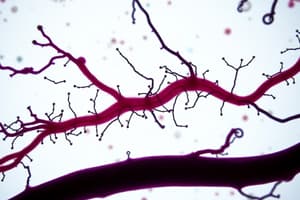Podcast
Questions and Answers
When observing a specimen under the microscope, which objective lens requires the use of oil immersion to enhance resolution?
When observing a specimen under the microscope, which objective lens requires the use of oil immersion to enhance resolution?
- 4x objective
- 100x objective (correct)
- 10x objective
- 40x objective
What is the primary reason for using immersion oil with a microscope objective?
What is the primary reason for using immersion oil with a microscope objective?
- To decrease the working distance between the lens and the slide.
- To prevent loss of light due to refraction. (correct)
- To increase the magnification of the lens.
- To stain the specimen for better visibility.
Which of the following actions should be performed before storing a microscope after use?
Which of the following actions should be performed before storing a microscope after use?
- Switch to the lowest power objective lens and lower the stage. (correct)
- Remove the objective lens and store it separately.
- Clean the lenses with excessive amounts of solvent to prevent contamination.
- Leave the oil immersion lens in place for the next user.
If a cell appears blurry when switching from the 40x to the 100x objective lens, and adjusting the fine focus knob does not improve clarity, what is the most likely cause?
If a cell appears blurry when switching from the 40x to the 100x objective lens, and adjusting the fine focus knob does not improve clarity, what is the most likely cause?
What is the function of the condenser in a light microscope?
What is the function of the condenser in a light microscope?
When preparing a bacterial smear for staining, what is the purpose of heat fixing?
When preparing a bacterial smear for staining, what is the purpose of heat fixing?
Why is it important to air dry a bacterial smear before heat fixing?
Why is it important to air dry a bacterial smear before heat fixing?
In Gram staining, what is the role of iodine?
In Gram staining, what is the role of iodine?
Why do acid-fast bacteria require a special staining procedure?
Why do acid-fast bacteria require a special staining procedure?
What is the purpose of a counterstain in differential staining techniques like Gram staining or acid-fast staining?
What is the purpose of a counterstain in differential staining techniques like Gram staining or acid-fast staining?
Flashcards
Resolution
Resolution
The ability of microscope lenses to distinguish two close points as separate.
Magnification
Magnification
The ability to enlarge an object's appearance through lenses.
Lens for oil immersion
Lens for oil immersion
100x objective lens, providing a total magnification of 1000x.
How immersion oil enhances resolution
How immersion oil enhances resolution
Signup and view all the flashcards
Maximum microscope resolution
Maximum microscope resolution
Signup and view all the flashcards
Total magnification calculation
Total magnification calculation
Signup and view all the flashcards
Microscope preparation
Microscope preparation
Signup and view all the flashcards
Fixing lighting issues
Fixing lighting issues
Signup and view all the flashcards
Condenser function
Condenser function
Signup and view all the flashcards
Diaphragm function
Diaphragm function
Signup and view all the flashcards
Refractive index
Refractive index
Signup and view all the flashcards
Parfocal
Parfocal
Signup and view all the flashcards
Gram stain
Gram stain
Signup and view all the flashcards
Heat fixing
Heat fixing
Signup and view all the flashcards
Simple stain
Simple stain
Signup and view all the flashcards
Mordant
Mordant
Signup and view all the flashcards
Counterstain
Counterstain
Signup and view all the flashcards
Acid-fast staining diseases
Acid-fast staining diseases
Signup and view all the flashcards
Special cell wall feature
Special cell wall feature
Signup and view all the flashcards
Produce because
Produce because
Signup and view all the flashcards
Study Notes
- These notes cover identification of eukaryotes, bacterial morphologies and arrangements, microscope skills, staining techniques, and bacterial characteristics
Identifying Eukaryotes Under a Microscope
- Schistosoma mansonni (Helminth) at 40X magnification
- Enterobius (Parasitic Worm) at 10X magnification
- Anabena (Cyanobacteria) at 40X magnification
- Peridinium (Dinoflagellate) at 40X magnification
- Spirogyra (Algae) at 10X magnification
- Diatoms (Algae) at 40X magnification
- Paramecium (Protozoa) at 40X magnification
- Trichomonas vaginalis (Parasitic Protozoa)
- Trypanosoma gambiensae (Parasitic Protozoa mixed with RBCs), viewable under 100X magnification
- Penicillium (Fungi, Mold type with purple slide) at 40X magnification
- Rhizopus (Fungi, Mold type with pink slide) at 40X magnification
- Aspergillus (Fungi, Mold type with green slide) at 40X magnification
- Saccharomyces cerevisiae (Fungi) at 100X magnification
- Culex (Vector) at 4X magnification
- Pulex (Vector) at 4X magnification
Identifying Bacterial Morphologies and Arrangements
- Coccus bacterial morphology at 1000X magnification
- Spirillum bacterial morphology at 1000X magnification
- Rod/bacillus bacterial morphology at 1000X magnification
- Staph bacterial arrangement at 1000X magnification
- Strep bacterial arrangement at 1000X magnification
Distinguishing Prokaryotes from Eukaryotes
- Know diseases that each organism can cause, if any result from infection
Microscope Skills
- Identifying microscope parts
- Using all objective lenses, including the oil immersion lens
- Locating and focusing specimens using oil immersion techniques
Resolution vs. Magnification
- Resolution is the ability to distinguish two points
- Magnification is the ability to enlarge an object
Oil Immersion
- Use oil with the 100x objective lens (total 1000x magnification)
- Immersion oil enhances resolution by preventing light loss and having the same refractive index as glass
Maximum Microscope Resolution
- Maximum resolution is 0.2um with a 100x objective
Total Magnification
- Determine total magnification by 10x multiplied by the objective lens number
Microscope Preparation
- Before storing, switch to 4x (or 40x) and lower the stage
Improving Lighting
- If cells appear washed out, increase light, use oil immersion with the 100x lens, adjust the diaphragm, or use coarse and fine focus
Microscope Parts
- Condenser: focuses light into the specimen
- Diaphragm: controls the amount of light
- Objective lenses: 10x, 40x, 100x (low, high, dry, oil immersion)
- Ocular lens: magnifies image 10x
- Eyepiece: part you look through
- Coarse adjustment: moves stage up and down for focusing
- Fine adjustment: moves stage slightly to sharpen the image
- Stage: holds the microscope slide in place
- Mechanical stage adjuster
Light Path
- Trace the light path through a microscope, starting with the light course, diaphragm, condenser, stage, objectives, revolving nose piece, body tube, and ocular lens
Eukaryotes and Prokaryotes
- Identify eukaryotes and prokaryotes
- If transitioning from 40x to 100x and the cell disappears; center the specimen, open the diaphragm, use fine focus, clean lenses, and ensure the lens is clicked into place
Cellular Morphology
- Cellular morphology describes the shape, size, arrangement, and staining reaction of cells
- Includes coccus, spirillum, and bacillus shapes
Field of Vision
- The field of vision is smaller at higher powers; center objects to avoid losing them
- Use the mechanical stage adjuster to adjust
Refractive Index
- The amount that light bends
Parfocal Lenses
- Focus under lower power before moving to higher power
Gram Stain
- Know how to perform, prepare an A+ smear, what the stain helps identify
Preparing a Smear
- Spread cells evenly, avoid clumps, mark smear location, label slide, and heat fix
Focusing Stained Slides
- Focus stained slides under oil immersion
Heat Fixing
- Heat fixing adheres the specimen to the slide for staining
Drying Smears
- Air dry smears before heat fixing to prevent lysis
Staining Techniques
- Simple Stain: observe basic external structures; uses methylene blue
- Gram Stain: identify cell wall type; uses crystal violet, iodine, ethanol, safranin. Gram-positive have thicker peptidoglycan with no outer membrane. Gram-negative have thinner peptidoglycan and an outer membrane
- Acid-Fast Stain: identify mycolic acids in Mycobacterium; uses cabolfuchsin, acid alcohol, methylene blue
Role of Iodine
- Iodine fixes crystal violet to the cell wall
Gram Stain Reactions
- Gram-positive organisms maintain the crystal violet-iodine complex due to their cell wall structure
Gram Stain Reagents
- Crystal violet (primary stain): colors the cell purple
- Iodine (mordant): fixes crystal violet to the cell wall
- Ethanol (decolorizer): removes crystal violet from gram-negative cells
- Safranin (counterstain): stains gram-negative bacteria pink
Mordant and Counterstain
- Mordant improves stain adherence
- Counterstain provides contrasting color
Acid-Fast Staining Importance
- Acid-fast staining is important for identifying TB and leprosy to diagnose Mycobacterium tuberculosis
Acid Fast Cell Walls
- A high lipid content
Acid-Fast Stain
- Carbolfuchsin (primary stain, red); lipid soluble
- Acid alcohol (decolorizer): removes unbound carbol fuchsin
- Methylene blue (counterstain): contrasts non-acid fast cells
- Cannot penetrate mycolic acid;
Bacteria and Endospores
- Bacillus and Clostridium produce endospores, a survival mechanism under harsh conditions
Disease and Sporulating Bacteria
- Endospores allow bacteria dormancy, resistant to heat, UV, desiccation, and chemicals
- Sporulating bacteria cause Enterocolitis, Pseudomembranous colitis from Clostridium difficile (C.diff), and Clostridium Tetani
Gram Stain Identification
- Identify gram-positive cocci and rods, and gram-negative rods
Identifying Acid Fasts
- Identify acid-fast positive and negative bacteria
Studying That Suits You
Use AI to generate personalized quizzes and flashcards to suit your learning preferences.




